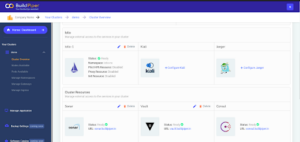
Service mesh is the next best move that enterprises can take to overcome security and networking challenges obstructing Kubernetes deployment and container adoption. Check out some of the popular tools for deploying service mesh here in this blog!
What is a Service Mesh?
Before we read about these tools, let’s know what is Service mesh in Kubernetes. A service mesh is a technology pattern that can be applied to microservices-based applications for managing networked communication between services. It ensures that the communication between the services within the containerized infrastructure is fast, reliable, and secure.
In the 2020 Cloud-Native Survey, the Cloud Native Computing Foundation (CNCF) found that the use of service mesh in production has jumped by 50% from last year.
Here are some of the popular service mesh tools for managing service-to-service connections and providing developers with valuable benefits of observability, traffic control and security. Let’s take a look!
Istio
ISTIO Service Mesh is a configurable, open-source service-mesh layer that acts as a reliable solution to monitor and control how microservices share data with one another. ISTIO provides a clear and language-independent way to flexibly and easily automate the network functions within an application.
ISTIO allows IT teams to add capabilities of observability, traffic management, and security to the applications, without actually writing codes for adding these functionalities to the app. With service mesh, there is no need for developers to write codes for networking and security from scratch.
Moreover, this popular service meshing technology enables DevOps & SRE teams to secure, connect, and monitor microservices, so they can modernize their enterprise applications at a faster pace and securely.
You’ve already read about what is Service mesh in Kubernetes. So, now let’s explore the ISTIO architecture. Here’s a brief description of the ISTIO architecture. The Istio architecture comprises two main components,
- The Control Plane: It is used to configure and manage proxies in the data plane.
- The Data plane: The second main component of the ISTIO service mesh is the Data plane which is composed of a set of intelligent proxies known as Envoy. These proxies are deployed as sidecars. They control all network communication between microservices.
[Good Read: The Art of Deploying a Service Mesh!]
Linkerd
Next on the list of popular service mesh tools is Linkerd. Linkerd is an open-source, security-first service mesh for Kubernetes. Linkerd adds critical security, observability, and reliability features to the Kubernetes stack with no code change required. This transparent service meshing technology makes modern applications safe and secure with its unique features including service discovery, load balancing, failure handling, instrumentation, and routing to all inter-service communication.
Linkerd acts as a transparent HTTP/gRPC/thrift/etc proxy, and can usually be plunged into existing applications with a minimum of configuration, regardless of what language they’re written in. It works with several common protocols and service discovery backends, including scheduled environments such as Mesos and Kubernetes.
Consul
Consul is a multi-cloud service networking platform to connect and secure services across any runtime platform and public or private cloud. It is a service mesh solution that provides a full-featured control plane with functionalities like service discovery, configuration, and segmentation. Each of these features can be used individually as needed, or they can be used together to build a complete service mesh.
Consul can be used to exhibit services and nodes on a flexible interface that allows users to have an updated view of the complete infrastructure they are a part of. It demands a data plane and supports both a proxy and native integration model. It operates through a simple built-in proxy and supports 3rd party proxy integrations such as Envoy. It runs on Linux, macOS, FreeBSD, Solaris, and Windows and includes an optional browser-based UI.
The Real Crux!
A service mesh is responsible for constantly keeping up with significant security concerns within the cloud environment. This is why deploying a service mesh has become a major priority for enterprises these days. But, as an app grows and scales, the complexity of monitoring microservices increases.
For this, you need the right tools, a proficient team and a powerful Microservices management platform such as BuildPiper, to tranquillize the intricacies of deploying a service mesh.
BuildPiper- The Cream of the Crop!
With BuildPiper’s support for an effective and powerful service mesh such as ISTIO, DevOps teams can leverage the out-of-the-box capabilities of ISTIO for traffic management and ensure smooth, secure and compliant Microservices application delivery.
Here is a comprehensive overview of the Kubernetes cluster offered by BuildPiper after the setup of ISTIO service mesh, Kiali, a management console and Jaeger, open-source software to track and trace transactions between distributed services.
ISTIO on BuildPiper is offered as a managed add-on that allows seamless integration of ISTIO with the Kubernetes cluster. With a single click, teams can deploy a compatible and secured production-ready ISTIO instance on the Kubernetes Service cluster. Besides providing support for ISTIO setup and ISTIO Gateways, BuildPiper backs the complete setup of Kiali and Jaeger.
Consult our tech experts to discuss your critical business use cases and major security challenges. Schedule a demo today!




